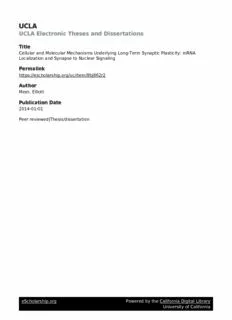
Cellular and Molecular Mechanisms Underlying Long-Term Synaptic Plasticity: mRNA Localization ... PDF
Preview Cellular and Molecular Mechanisms Underlying Long-Term Synaptic Plasticity: mRNA Localization ...
UCLA UCLA Electronic Theses and Dissertations Title Cellular and Molecular Mechanisms Underlying Long-Term Synaptic Plasticity: mRNA Localization and Synapse to Nuclear Signaling Permalink https://escholarship.org/uc/item/8bj862r2 Author Meer, Elliott Publication Date 2014 Peer reviewed|Thesis/dissertation eScholarship.org Powered by the California Digital Library University of California UNIVERSITY OF CALIFORNIA Los Angeles Cellular and Molecular Mechanisms Underlying Long-Term Synaptic Plasticity: mRNA Localization and Synapse to Nuclear Signaling A dissertation submitted in partial satisfaction of the Requirements for the degree Doctor of Philosophy in Biological Chemistry by Elliott Meer 2014 © Copyright by Elliott Meer 2014 ABSTRACT OF THE DISSERTATION Molecular Mechanisms Underlying Long-Term Synaptic Plasticity: mRNA Localization and Synapse to Nuclear Signaling by Elliott Meer Doctor of Philosophy in Biological Chemistry University of California, Los Angeles, 2014 Professor Kelsey C. Martin, Chair Synaptic plasticity, changes in the number and strength of synaptic connections in the brain, represents the best-characterized correlate of learning and memory. Long-term synaptic plasticity is a transcription- and translation-dependent process that can be restricted to subsets of synapses within a single neuron. The model system Aplysia californica provides an excellent model system to study the cellular and molecular mechanisms underlying long-term, learning- related synaptic plasticity. In this thesis, I investigate two cell biological questions that emerge from the requirement for gene expression during synapse-specific plasticity. The first question concerns the spatial regulation of gene expression within neurons. Here, we propose that one mechanism for restricting gene expression to individual synapses is through mRNA localization and regulated translation. I have identified a 66 nucleotide sequence in the 5’UTR of sensorin mRNA that when paired with the sensorin 3’UTR is required and sufficient for sensorin mRNA synaptic localization. My experiments further indicate that this localization element is encoded by a stem-loop structure (Meer et al., 2012). The second question concerns the mechanisms by ii which synaptically-generated signals are transported from the synapse to the nucleus to initiate transcription. Using the Aplysia sensory-motor co-culture system, I found that the transcriptional regulator CREB-regulated transcriptional co-activator (CRTC) is required for activity-dependent long-term facilitation. Aplysia CRTC (ApCRTC) accumulates in the nucleus when cultures are treated with stimulation inducing activity-dependent heterosynaptic plasticity, but not when treated with activity-independent heterosynaptic plasticity inducing stimulation. Electrophysiological studies show that ApCRTC is functionally required in the postsynaptic (motor) neuron, as injection of dominant-negative constructs block long-term synaptic plasticity. iii The dissertation of Elliott Meer is approved. Douglas L. Black James Akira Wohlschlegel Feng Guo Kelsey C. Martin, Committee Chair University of California, Los Angeles 2014 iv The work presented herein is dedicated to my family and friends. v Table of Contents List of Figures ...................................................................................................................................... vii Acknowledgements .......................................................................................................................... viii Vita ........................................................................................................................................................... ix Chapter 1: Introduction ..................................................................................................................... 1 Chapter 2: Identification of a cis-‐acting element that localizes mRNA to synapses .... 20 Chapter 3: Synapse to nuclear transport of ApCRTC is required postsynaptically during activity-‐dependent long-‐term facilitation of Aplysia sensory-‐motor synapses .................................................................................................................................................................. 48 Chapter 4: Discussion and Concluding Remarks ..................................................................... 71 References ............................................................................................................................................ 81 vi List of Figures FIGURE 1-1 .................................................................................................................................. 2 FIGURE 1-2 .................................................................................................................................. 6 FIGURE 1-3 .................................................................................................................................. 9 FIGURE 1-4 ................................................................................................................................ 10 FIGURE 1-5 ................................................................................................................................ 13 FIGURE 1-6 ................................................................................................................................ 16 FIGURE 1-7 ................................................................................................................................ 18 FIGURE 2-1 ................................................................................................................................ 33 FIGURE 2-2 ................................................................................................................................ 34 FIGURE 2-3 ................................................................................................................................ 36 FIGURE 2-4 ................................................................................................................................ 38 FIGURE 2-5 ................................................................................................................................ 39 FIGURE 2-6 ................................................................................................................................ 41 FIGURE 2-7 ................................................................................................................................ 42 FIGURE 2-8 ................................................................................................................................ 43 FIGURE 2-9 ................................................................................................................................ 44 FIGURE 2-10 .............................................................................................................................. 45 FIGURE 2-11 .............................................................................................................................. 46 FIGURE 3-1 ................................................................................................................................ 63 FIGURE 3-2 ................................................................................................................................ 65 FIGURE 3-3 ................................................................................................................................ 67 FIGURE 3-4 ................................................................................................................................ 69 FIGURE 4-1 ................................................................................................................................ 74 vii Acknowledgements I would first like to acknowledge my family: James, Wendy, Julian and of course Maverick. Without the love and support I received from all of you during my time in graduate school I would not have made it all the way through. To quote my mother “don’t worry, be happy, it will all work out.” The wonderful, and at times strange, adventures I’ve had over the years with my friends took the strain out of working at the bench. You provided a distraction from my frustration when experiments refused to cooperate and were always there to put a smile on my face. No one should go through graduate school alone, and I consider myself lucky to have had such amazing friends. Ohtan, I cannot overstate the impact you had on my time in graduate school. I can still remember when I first joined the Martin lab, I felt like I had been dropped in your lap. Not only did you help train me, you treated me like a colleague. The passion and drive you instilled in me with your own love of science has left its mark, and for this I am eternally grateful. Kelsey, you provided support and mentorship more than any graduate student could hope for. Thank you for giving me the opportunity to grow as both a scientist and as a person. To the rest of my committee: Doug Black, James Wohlschlegel and Feng Guo. Thank you for your valuable comments, advice, and taking the time to keep my graduate career on track. The work presented in chapter 2 of this dissertation is reproduced from: Meer EJ*, Wang DO*, Kim S, Barr I, Guo F, Martin KC, Identification of a cis-acting element that localizes mRNA to synapses, PNAS. 109, 4639-44, 2012. PMCID: PMC3311331. *equal contribution The work presented in chapter 3 of this dissertation is reproduced from: Meer EJ, Uzgil B, Ch’ng TH, DeSalvo M, Lee P, Martin KC. Synapse to nuclear signaling of CRTC is required postsynaptically in response to activity-dependent forms of long-term synaptic plasticity. In preparation, 2014. viii
Description: